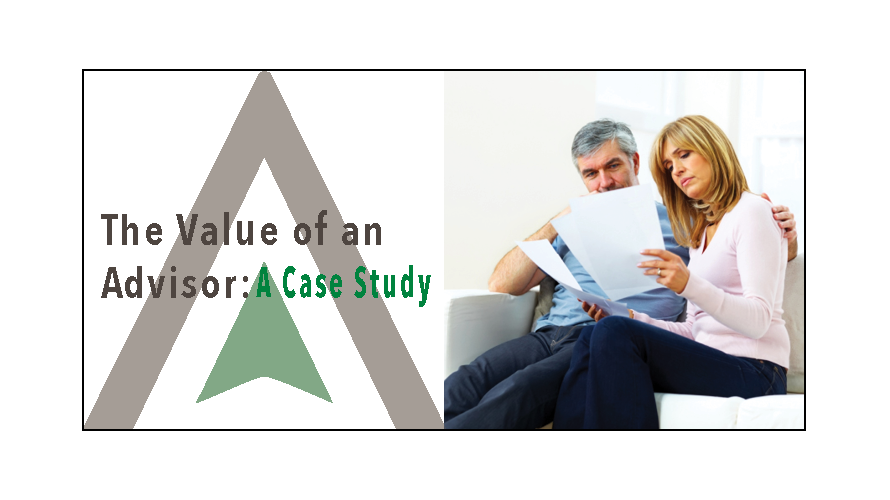Through a series of blog posts over the past few months, we have shared the many ways a financial advisor can add value to your financial life above and beyond the returns your portfolio will generate. We discussed many strategies and ideas around how this value can be realized and also wanted to share an example of how all these pieces fit together. From withdrawal strategies and portfolio construction to financial and behavioral guidance, there are many ways your advisor could add value. Here is an example of how we helped Jane and John Anderson (names changed for privacy).
During our initial meetings with the Andersons, we spent most of the time learning about their family history, shared goals, unique values, and future aspirations. During the course of conversation, we were also able to learn more about their concerns and what life transitions worried them. Jane and John are both 61 years old and have two adult children who live out of state. They were excited to be welcoming their first grandchild later this year. Jane has worked as an executive at a large company in Minnesota for the past 10 years and received stock compensation while she was in this position. They have worked hard at saving for retirement and wanted to explore an early retirement or phased retirement plan over the next few years. As we began our financial advisory relationship, we were able to make adjustments to their portfolio, formalize a plan for retirement, and find efficient ways to achieve their other financial life goals.
Portfolio Construction
Jane and John each had roughly $1M in former and current employer 401(k) plans as well as a joint taxable brokerage account worth $500,000 for a total portfolio balance of $2.5M. This did not include $200,000 in restricted stock units (RSUs) and stock options that had some value but were difficult for them to quantify because only some shares had vested. We recommended that they both transition their old 401(k) accounts into new Rollover IRA accounts where we could not only find lower-cost index options, but also use some best-in-class active managers in some major asset classes that were not available through their 401(k) investment menus. By placing the 401(k)s under our care, we would also be able to provide active oversight on what was the largest portion of their wealth by reviewing their portfolio every 10 business days to ensure their overall allocation was appropriate for their goals while mitigating risk in areas that had become stretched over the course of a rising market.
Through our diligent discovery process, we learned that Jane and John both felt comfortable pursuing an investment mandate that would include socially responsible and ESG (Environmental, Social, Governance) principles. We also guided them through a risk questionnaire to get objective insights into their comfort around market volatility, which fed into our portfolio construction process. Since their 401(k) accounts had not been rebalanced in several years and they were closer to being able to retire than they had anticipated, we suggested downshifting from a Growth investment strategy to a Moderate Growth strategy with less equity risk. We felt comfortable doing this because, as we will discuss in greater detail in the next section, the results of their retirement projection were quite strong and they did not need the potential return the added equity risk might provide.
We also felt we could achieve greater productivity in the portfolio by targeting higher returning asset classes and by using cheaper institutional share classes. We created an inflation hedge using a variety of securities that were responsive to inflation in order to help protect the greater exposure to bonds from a rising interest rate environment. Over the course of several months, we carefully shifted out of some of their more expensive large-cap growth stock exposure into cheaper segments of the market, including small-cap, value, and international stocks to gain greater diversification, all the while managing taxes by choosing to do this in their IRAs instead of their taxable account.
In the taxable account, we harvested some losses that their previous investment advisor had left alone and added exposure to similar investments in a tax-efficient exchange traded fund (ETF) that also favored the ESG traits we knew were important to Jane and John. Because they were adding steadily to their taxable account, we decided to build most of the new bond exposure in their IRAs where higher dividends and interest income could be tax sheltered. Finally, we prepared a customized analysis of their RSU and stock option vesting schedules along with an estimate of their employer stock prices so they could be better informed about when these would vest. We included a recommendation for when to exercise in order to realize the value that would support their ability to retire early.
Although Jane and John intend to retire in the next few years, we will provide guidance and recommendations while they are working on their current 401(k) plans to ensure the allocation within these accounts is also working to support their retirement goals.
Financial Life Planning
Jane and John were concerned about how best to draw money from their portfolio once they enter retirement. After years of living off their paychecks, they were concerned, like many pre-retirees, about turning off the spigot and drawing exclusively from their nest egg. As mentioned, they would like to phase into retirement over the next few years. They do not anticipate needing money from the portfolio while they are working but would need to take money from the portfolio once they are fully retired at age 64. The most tax-efficient way to distribute money from the portfolio would be to spend from the brokerage account or use Jane’s stock proceeds first. Then, when they are required to take distributions from their IRA accounts (at age 72), a majority of the money they need for living expenses will come from this distribution. We also discussed converting some of their retirement account money (IRA) to a Roth IRA in the years they are fully retired before they receive other retirement income. They will be able to maximize their Social Security benefits by waiting to claim at age 70. So, from age 64 until age 70, they will have minimal income to report each year. The Roth conversion strategy allows them to maximize a lower tax bracket today and convert money to a tax-free vehicle. This will also reduce their required distribution amount in future years, which then lowers future taxable income, giving them more money to redirect to other uses.
They have also expressed an interest in gifting to both their kids and grandchildren as well as to charities. Jane and John’s initial retirement projection included a desired retirement spending amount, an amount for travel each year to visit their kids, and money for health care costs. The results of this projection were strong, so we were able to explore other goals that were on their wish list, including $5,000 annual gifts to each of their kids. These annual gifts, along with the annual contributions to their grandchildren’s 529 plans, are tax-free because they are under the annual exclusion amount. Jane and John feel strongly about watching their family benefit from their savings while they can enjoy it versus leaving money to family in their estate. They also want to give money to charitable organizations they care about but worried they couldn’t afford to give to both family and charity. We discussed the option of naming charitable organizations as the beneficiary on their IRA accounts and can revisit giving money from their IRA accounts directly to charity once they are over age 70 as this distribution would be excluded from ordinary income.
Jane and John shared with us early in the conversation their concern with market volatility in retirement. After the first couple of months working with JNBA, the market saw a pullback, and Jane and John wondered if they should pull some money out to cash for safekeeping. We noted that we maintain a small cash balance for all retirees that will support short-term spending needs to reduce both the financial and emotional stress caused by market volatility. After all, part of our role as their financial advisor is helping to stay the course in times of discomfort and not missing out on future opportunities in their portfolio that will help support their goals. Investing money can be very emotional, especially in the first few years following retirement. We believe a disciplined strategy will help Jane and John stay on track to achieving their retirement goals and that unemotional decision-making will be some of the greatest value we provide to them in those times.
While there are many other ways we can support and advocate for the Andersons, we hope these initial examples help to paint a picture of what the Value of an Advisor might provide to you.
Value of an Advisor: Portfolio Construction
Value of an Advisor: Guidance & Confidence
Value of an Advisor: Withdrawal Strategies
Value of an Advisor: Financial Life Planning
Should you be looking for an advocate to help you successfully plan for and navigate your life transitions, please reach out to JNBA Financial Advisors for an initial conversation.
Due to various factors, including changing market conditions and/or applicable laws, the content may no longer be reflective of current opinions or positions. Moreover, you should not assume that any discussion or information contained in this blog serves as the receipt of, or as a substitute for, personalized investment advice from JNBA Financial Advisors, LLC.
Please see important disclosure information at www.jnba.com/disclosure.



